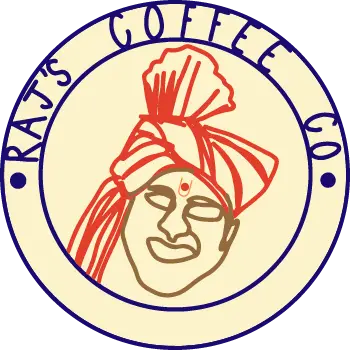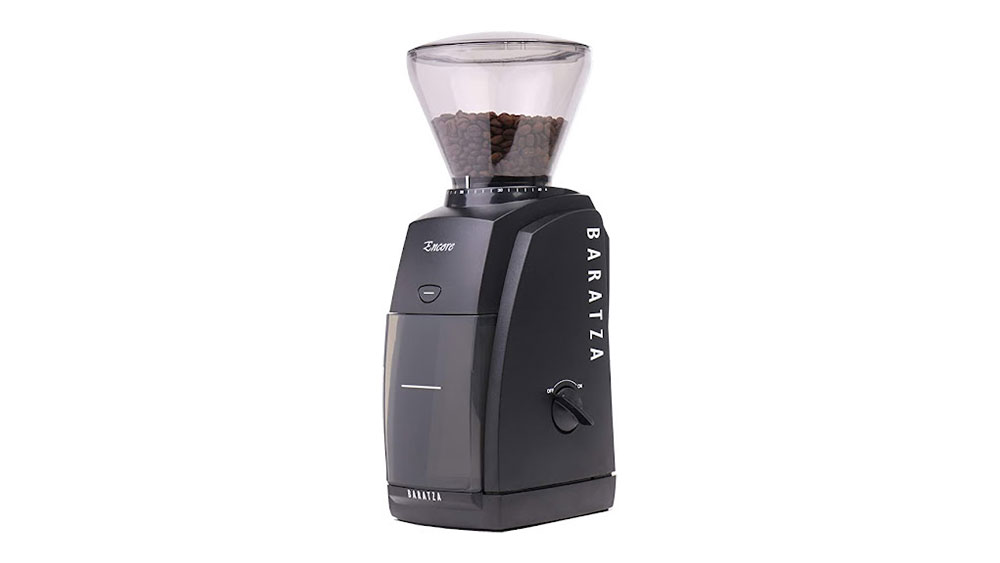Building a coffee bar for your home can be something tricky to really conceptualize. You want to have stunning coffee available in your home, but what does that mean when it comes to actually build a system in your kitchen?
Well, in this article, we’re going to run through some of the key features of a great home coffee bar, talk about what they’re for, and suggest a couple of great options for you.
This article is, by no means, an extensive list. However, we would consider this list a great place to start dipping your toe into the world of generating your own coffee bar at home. For all of the points in this article, it’s very likely that we’ll address them in finer detail with their own article. For now, though, we’re simply going to speak about some important big things to bear in mind.
Coffee Storage
Coffee storage is more important than you might think. The reason for this is that the flavor compounds within coffee are soluble in the oil that is stored within the bean. Over time, beans will secrete their flavors into the coffee oils, which will then lead to the oil evaporating, and the coffee itself losing flavor.
Generally speaking, the best way to prevent this from happening is to store your beans in an airtight environment. This will prevent the coffee flavors from evaporating within your kitchen, and the beans from losing flavor.
A product that is commonly recommended within this sphere of products is the OXO good grips pop range. These products revolve around a fairly simple core concept – the product is large enough to store coffee beans, and the button on top serves to create a near-perfect vacuum seal around the rim of the container.
While these containers do have some level of drawbacks, they’re popular for a reason – they’re cheap and work really well. This makes them a stunning entry-level point in the world of coffee storage.
Grinders
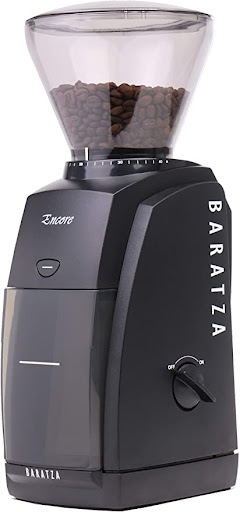
There have been thousands and thousands of different words written and spoken about coffee grinders. From the physics of how static on the beans interacts with the burrs of a grinder to how different grinding materials lead to different levels of retention, we’d never cover everything there is to say about grinders in this article.
Instead, we’re going to tell you to look out for one thing if you’re a newbie to coffee – burr grinders.
Burr grinders are what they sound like – a grinding machine that uses a set of two burrs (ridged pieces of material) to physically crush beans to a powder. This differs from cheaper grinders as those cheaper grinders tend to make use of blades to slice the beans.
Blade grinders typically result in a more uneven consistency throughout the grind itself, which makes the coffee you brew much more unpredictable.
The Baratza Encore is commonly regarded as the best entry-level grinder. With a price tag of $170 at the time of writing, it’s a fairly expensive entry-level product, but the consistency and predictability of grind make it infinitely easier to control the brew that you’re creating.
This product is a great entry-level option since it is exceptionally user-friendly, and it has a very small footprint, meaning that it doesn’t take up a lot of space. Furthermore, the product has a one-year warranty, allowing you a healthy dose of peace of mind.
Kettles
Considering what kettle you’re going to use depends almost entirely upon what type of brewing you’re going to be doing. If you’re brewing coffee in any way other than a pourover brew, you’ll be largely served well by the kettle you already have.
If you’re making filter coffee through a pourover filter, a gooseneck kettle will serve you well. The reason for this is that gooseneck kettles greatly slow the rate at which you pour water, and give you a greater level of control over the direction of water that you’re pouring. In turn, this can give you a greater level of control over the flavors in your coffee, leading to a better cup.
A great option when building a beginner coffee bar is this choice from Shewe. We really like the fact that it has a number of preset temperatures that will allow you to totally avoid scalding the coffee that you brew, leading to much better-tasting cups of coffee in your home.
Filter Brewers
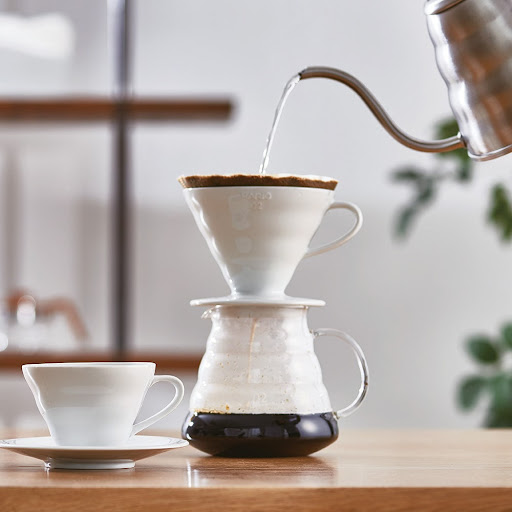
Brewing coffee in a filtered sense is the most common way for people to begin down the long, winding path of specialty coffee. The reason for this is that it’s very simple and understandable – simply adjusting the way in which you pour coffee will help you to make wonderful drinks.
The long-standing champion of filter brewers is the Hario v60. It’s a stunningly simple brewer that makes use of paper filters to ensure that every cup you brew is smooth and clean.
The link we shared above is the ceramic version of the classic brewer, though you can also get versions in plastic and metal, depending upon what you might prefer. We really love the ceramic, to be honest – it just feels lovely as you brew.
The thing to bear in mind with filter brewers is that you do require some form of filter, unsurprisingly. Our personal favorite is the paper filter since it filters out such a wide range of different particle sizes without delaying the brewing time too much overall. Furthermore, paper filters are easy to use and throw out, since they’re designed to be single-use, before degrading easily. If you’re concerned about the environmental impact of your coffee, you could opt for a reusable filter. These cotton options are a great way to experience wonderfully smooth coffee while using a filter that can be reused several times over. Metal filters are also available, but the general consensus is that cotton filters will filter coffee more finely to create a smoother cup. If you’d be interested in a cup with some level of mouthfeel, though, you could opt for an immersion brewer.
Immersion Brewers
Immersion brewers are something of a different beast when it comes to coffee brewing. The general focus is simple – instead of water passing through the coffee, immersion brewers steep coffee as you would with tea, before filtering out the coffee as it is poured into your cup.
We like the french press as the easiest, most straightforward way to enjoy specialty coffee in your home. The thing that really makes it totally impressive is the fact that the coffee you make is filtered through a reusable metal filter. This leads to a different mouthfeel than the coffee we spoke about above, which is something that you may, or may not, enjoy.
This option from Bayka is a great option to get started with a pretty, and easy-to-use, french press in your home. This means that you could easily create tasty coffee with relatively little effort.
There is a range of different methods that you could use with your French press to make the ultimate coffee for you, but the thing that makes them so great is the fact that they’re affordable and long-lasting. A pretty French press can sit on your side for a number of years without needing any maintenance other than cleaning – there are few other brewers for which you can say that.
Espresso Machines
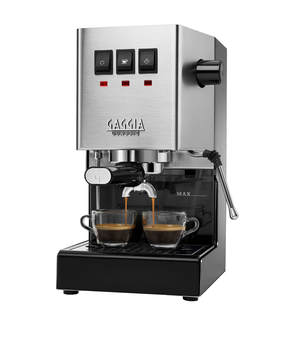
The world of espresso machines is deeply complicated. The reason for this is that, as far as we understand, the world of mechanics is complex, and the world of coffee is complex. When those two worlds are combined, it results in an exceptionally complex and difficult list of different variables.
The main thing that we would suggest bearing in mind when considering espresso machines is that you should look for a machine with a 58mm portafilter. This will mean that the small, handheld piece of the machine that you can remove is exactly 58mm in diameter – the most common size of this piece of equipment.
The reason we recommend this is that making good espresso is about striking a balance between the espresso machine’s pump forcing water through the coffee, and the coffee puck putting resistance up against the pump.
In a machine with a 58mm portafilter, you can specifically avoid using a basket that is pressurized to ensure that huge amounts of pressure (too much) are always used. Instead, you can customize the pressure balance by being sure to grind and tamp coffee into the machine properly.
To that end, we would recommend the Gaggia classic as an entry-level machine. It has the option to use a non-pressurized basket out of the box, and Gaggia, as a brand, has been established for a long, long time. This means that their balance of customer service and their ability to create great machines has been long tested – they’re certainly good at it.
Milk Steamers and Frothers
Steaming and frothing milk is a complex, tricky thing to manage. The reason for this is that it involves steam, which can be exceptionally dangerous. We’ve lost touch with that in our modern age, but it’s entirely true – steam is a tricky thing to manage.
Most espresso machines do have a steaming wand built into the machine itself as standard. This means that the machine will be perfectly capable of creating and dispensing steam as it sees fit, allowing you to learn to use that to make steamed milk.
To get a milk steamer outside of an espresso machine, there are surprisingly few options. Really, your best option is this – the Bellman stovetop milk steamer.
This milk steamer heats water on your stovetop in the base, which will turn to steam, and can be managed using a dial on the side. This steam can be used to steam milk for your coffee drinks.
This option does work really well, though it can be a little tricky to get the hang of. To be sure that you’re being totally safe, we would recommend having a bowl of cool water nearby, just in case. That will take the water away from boiling, immediately reducing pressure within the Bellman.
Alternatively, you could opt for something like the Zulay milk frother. These handheld affairs are essentially designed to whisk air into your milk very rapidly. If you’re already heating milk in a microwave, this can be a great way to easily whip some air into hot milk – try it out, you’ll likely be surprised at how effective it is!
Accessories
There are always great coffee accessories out there in the world that would make a wonderful addition to your home coffee bar, and we’re going to talk about a couple of them here.
We really like the LuxHaus calibrated tamper, since it uses a spring mechanism to ensure that you always tamp at precisely the right level of pressure. This feature will ensure that the coffee within your portafilter is well distributed to allow for the ideal level of coffee extraction that you might be exploring.
We also like that this option comes in a range of sizes. While 58mm is the standard size for a portafilter, they can come in some other sizes too. To be sure that you get the right size, make sure you measure your portafilter.
We haven’t really spoken about cold brew coffee much on the site at this point, but it’s a fascinating world of sweet and exciting flavors that we love to see. To be sure that the coffee you brew is as delicious as possible, we would recommend opting for a specialist cold brew brewer, such as this one, from Takeya.
This option allows for a very simple and easy-to-manage immersion brew, leading to tasty cold-brew coffee in no time at all. To be sure that the coffee brews easily, a brewer like this is ideal, as you can simply pour out the brewed coffee when you’re happy with it.
Conclusion
We hope that this short article on the various things you might need to build out your home coffee bar has helped to create an image in your mind. We’d certainly advise you to go for it – a home coffee bar is always a brilliant investment!
